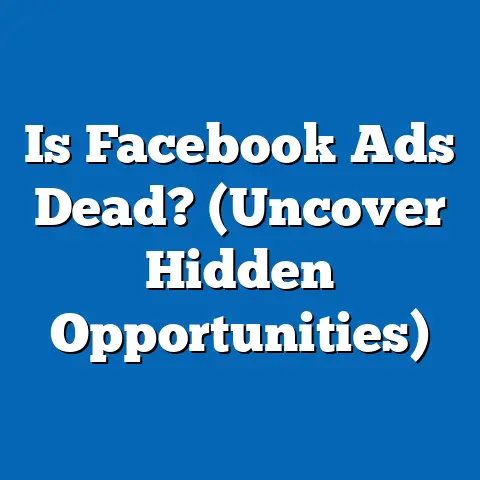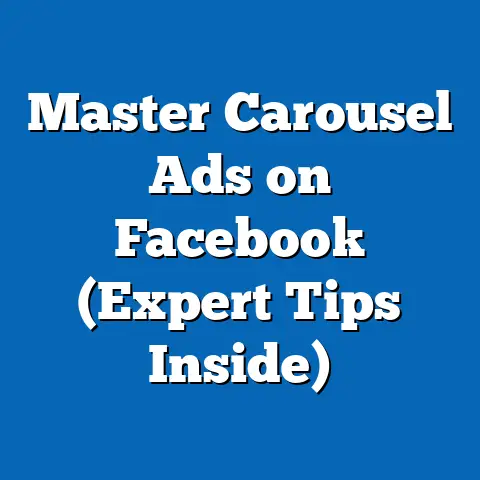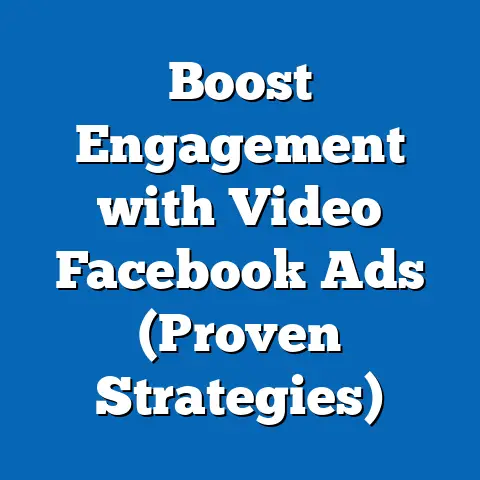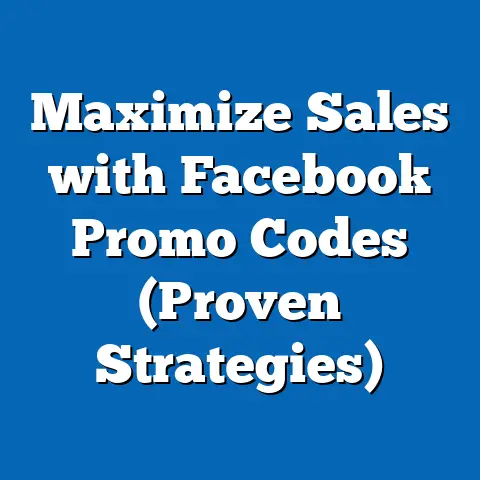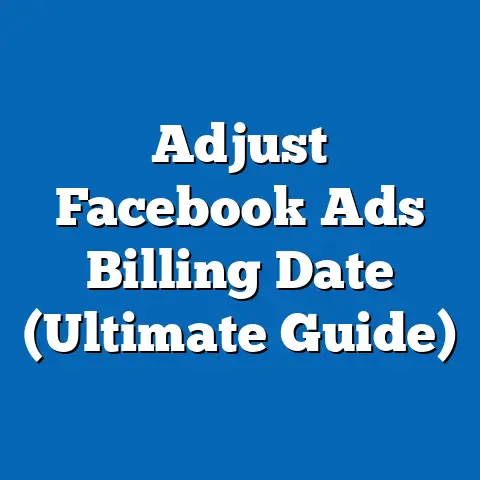Launch Facebook Ad Business Today (Step-by-Step Guide)
“Did you know that over 3 million businesses are currently using Facebook Ads to reach their target audience effectively?” This is a statistic that always blows my mind! It really underscores the massive potential of Facebook advertising. I’ve been working with Facebook Ads for years, and I’ve seen firsthand how it can transform businesses, both big and small. The ability to laser-target specific demographics, interests, and behaviors makes it incredibly powerful. That’s why I’m so excited to share this step-by-step guide to launching your own Facebook ad business. Whether you’re a seasoned marketer or just starting out, this article will give you the knowledge and tools you need to succeed. Let’s dive in!
Understanding the Facebook Advertising Landscape
Before jumping into the nitty-gritty of setting up your business, it’s crucial to understand the landscape you’re entering. Facebook advertising is a dynamic and ever-evolving world, and knowing the key players and principles will set you up for success.
The Importance of Facebook Ads
Facebook boasts a user base of billions, making it a prime platform for businesses looking to connect with their target audience. I remember when I first started using Facebook Ads, I was blown away by the sheer reach it offered. Compared to traditional advertising methods, Facebook allows you to target your ideal customer with incredible precision.
Think about it: you can target based on age, location, interests, behaviors, even life events like getting married or buying a new home. This level of granularity is simply unmatched by other platforms. Plus, with the right strategy, Facebook Ads can deliver a high return on investment (ROI), making it a lucrative channel for businesses of all sizes.
- Vast Reach: Connect with billions of potential customers worldwide.
- Precise Targeting: Target specific demographics, interests, and behaviors.
- Measurable Results: Track your campaign performance and optimize for ROI.
- Cost-Effective: Reach a large audience at a relatively low cost compared to traditional advertising.
Takeaway: Facebook Ads are a powerful tool for businesses looking to reach their target audience effectively and achieve a high ROI.
Key Features of Facebook Ads
Facebook offers a variety of ad formats, each with its own unique benefits. Understanding these formats and how to use them effectively is key to creating successful campaigns. Here’s a breakdown of some of the most popular options:
- Image Ads: These are simple, straightforward ads that feature a single image and text. They’re great for showcasing products or services and driving traffic to your website. I’ve found that using high-quality, visually appealing images is crucial for capturing attention in a crowded newsfeed.
- Video Ads: Video ads are incredibly engaging and can be used to tell a story, demonstrate a product, or share a testimonial. They’re a great way to connect with your audience on an emotional level and build brand awareness. I always recommend keeping video ads short and sweet – aim for under 15 seconds to maximize engagement.
- Carousel Ads: Carousel ads allow you to showcase multiple images or videos in a single ad unit. This format is perfect for highlighting different features of a product, telling a story, or showcasing a range of products. I’ve seen carousel ads work particularly well for e-commerce businesses.
- Collection Ads: Collection ads are designed for mobile shoppers and allow users to browse and purchase products directly from their Facebook feed. This format is ideal for e-commerce businesses looking to drive sales and increase conversions.
- Lead Ads: Lead ads make it easy for people to sign up for your newsletter, request a quote, or download a resource without leaving Facebook. This format is great for generating leads and building your email list. I’ve used lead ads extensively for B2B clients and seen excellent results.
Takeaway: Familiarize yourself with the different Facebook ad formats and choose the ones that best align with your campaign objectives and target audience.
Setting Up Your Facebook Ad Business
Now that you have a solid understanding of the Facebook advertising landscape, let’s move on to setting up your business. This involves creating a Business Manager account and defining your niche.
Creating a Business Manager Account
A Facebook Business Manager account is essential for managing your Facebook pages, ad accounts, and other business assets in one place. It allows you to collaborate with team members, assign roles and permissions, and track your overall business performance.
Here’s a step-by-step guide to setting up your Business Manager account:
- Go to business.facebook.com and click “Create Account.”
- Enter your business name, your name, and your business email address.
- Follow the prompts to provide more details about your business, such as your address and phone number.
- Verify your email address by clicking the link in the email that Facebook sends you.
- Add your Facebook page and ad account to your Business Manager account. If you don’t have a Facebook page yet, you can create one during this process.
- Set up your payment information so you can start running ads.
Pro Tip: Make sure to verify your business in Business Manager. This will give you access to more features and help you build trust with Facebook.
Takeaway: Setting up a Business Manager account is the first step in launching your Facebook ad business. It provides a central hub for managing your business assets and collaborating with team members.
Defining Your Niche
Choosing a specific niche for your ad business is crucial for success. Trying to be everything to everyone is a recipe for disaster. By focusing on a particular industry or type of business, you can develop specialized expertise, build a strong reputation, and attract clients who are a good fit for your services.
Here are some tips for identifying a profitable niche:
- Consider your interests and expertise: What are you passionate about? What industries or types of businesses do you have experience with?
- Research market trends: What industries are growing? What types of businesses are in high demand?
- Identify underserved markets: Are there any niches that are currently being overlooked by other ad agencies?
- Analyze your competition: What niches are your competitors targeting? Are there any gaps in the market that you can fill?
Once you’ve identified a potential niche, it’s important to validate your idea by conducting market research and talking to potential clients. This will help you determine whether there’s a real demand for your services and whether you can realistically build a successful business in that niche.
Example: Instead of offering Facebook ad services to all businesses, you could focus on e-commerce businesses selling sustainable products, or local restaurants in a specific city.
Takeaway: Choosing a specific niche will help you stand out from the competition, develop specialized expertise, and attract clients who are a good fit for your services.
Building Your Brand Identity
Your brand identity is how your business is perceived by the world. It’s more than just your logo and colors; it’s the overall feeling and message you convey to your target audience.
Crafting Your Brand Message
Your brand message is the core of your brand identity. It’s what you want people to remember about your business. It should be clear, concise, and compelling, and it should resonate with your target audience.
Here are some tips for crafting an effective brand message:
- Identify your target audience: Who are you trying to reach? What are their needs and pain points?
- Define your unique value proposition: What makes your business different from the competition? What unique benefits do you offer?
- Craft a clear and concise message: Use simple language and avoid jargon.
- Focus on the benefits, not the features: Explain how your services will help your clients achieve their goals.
- Test your message: Get feedback from potential clients and refine your message based on their input.
Example: Instead of saying “We offer Facebook ad management services,” you could say “We help e-commerce businesses increase sales and grow their brand with targeted Facebook ad campaigns.”
Takeaway: Your brand message should be clear, concise, and compelling, and it should resonate with your target audience.
Designing Your Brand Assets
Your brand assets are the visual elements that represent your brand, such as your logo, color scheme, typography, and imagery. They should be consistent across all of your marketing materials, including your website, social media profiles, and ad campaigns.
Here are some essential brand assets you’ll need:
- Logo: A professional logo that represents your brand and is easily recognizable.
- Color scheme: A consistent color palette that reflects your brand’s personality and values.
- Typography: A set of fonts that are used consistently across all of your marketing materials.
- Imagery: High-quality images and videos that are relevant to your brand and appeal to your target audience.
- Templates: Templates for your ads, social media posts, and other marketing materials to ensure consistency.
I always recommend investing in professional design services to create your brand assets. A well-designed brand identity can make a huge difference in how your business is perceived and can help you attract more clients.
Takeaway: Consistent brand assets are essential for building a strong brand identity and creating a professional image.
Creating Your First Facebook Ad Campaign
Now for the fun part! Let’s walk through the process of creating your first Facebook ad campaign. This involves setting campaign objectives, defining your target audience, and setting your budget and bidding strategies.
Setting Campaign Objectives
Your campaign objective is the goal you want to achieve with your ad campaign. Facebook offers a variety of campaign objectives, including:
- Awareness: Reach a large audience and increase brand awareness.
- Consideration: Drive traffic to your website, generate leads, or increase engagement with your content.
- Conversion: Drive sales, sign-ups, or other valuable actions on your website.
Choosing the right campaign objective is crucial for success. If you’re just starting out, you may want to focus on awareness or consideration objectives to build your brand and generate leads. Once you have a solid foundation, you can move on to conversion objectives to drive sales and revenue.
Example: If you’re launching a new e-commerce store, you might start with an awareness campaign to reach a large audience and introduce your brand. Then, you could run a consideration campaign to drive traffic to your website and encourage people to browse your products. Finally, you could run a conversion campaign to drive sales and encourage people to make a purchase.
Takeaway: Choose the right campaign objective based on your business goals and the stage of your marketing funnel.
Audience Targeting
Facebook’s targeting capabilities are one of its biggest strengths. You can target your ads to specific demographics, interests, behaviors, and even life events.
Here’s a step-by-step process for defining your target audience:
- Identify your ideal customer: Who are you trying to reach? What are their demographics, interests, and behaviors?
- Use Facebook’s targeting tools to define your audience: Explore the different targeting options and experiment with different combinations to find the most relevant audience.
- Create custom audiences: Upload your email list or website visitor data to create custom audiences of people who have already interacted with your business.
- Create lookalike audiences: Use your custom audiences to create lookalike audiences of people who share similar characteristics and are likely to be interested in your products or services.
I’ve found that creating detailed buyer personas is incredibly helpful for defining your target audience. This involves creating fictional representations of your ideal customers, including their demographics, interests, motivations, and pain points.
Takeaway: Use Facebook’s targeting tools to define your ideal customer and create highly relevant ad campaigns.
Budgeting and Bidding Strategies
Setting a budget and choosing the right bidding strategy are crucial for maximizing your ROI. Facebook offers two main budget options:
- Daily budget: The average amount you’re willing to spend each day.
- Lifetime budget: The total amount you’re willing to spend over the entire duration of your campaign.
Choosing between a daily and lifetime budget depends on your goals and the length of your campaign. If you’re running a long-term campaign, a daily budget may be more appropriate. If you’re running a short-term campaign, a lifetime budget may be a better option.
Facebook also offers several bidding strategies, including:
- Cost-per-click (CPC): You pay each time someone clicks on your ad.
- Cost-per-impression (CPM): You pay for every 1,000 impressions your ad receives.
- Cost-per-action (CPA): You pay for each specific action, such as a sale or sign-up.
The best bidding strategy depends on your campaign objective and your budget. If you’re focused on driving traffic to your website, CPC bidding may be the best option. If you’re focused on increasing brand awareness, CPM bidding may be more appropriate. If you’re focused on driving conversions, CPA bidding may be the best option.
Takeaway: Set a budget that you’re comfortable with and choose a bidding strategy that aligns with your campaign objective.
Crafting Compelling Ad Content
Your ad content is what will ultimately determine whether your campaign is successful. You need to create ad copy and visuals that capture attention, resonate with your target audience, and encourage them to take action.
Writing Effective Ad Copy
Your ad copy should be clear, concise, and compelling. It should highlight the benefits of your product or service and tell people what you want them to do.
Here are some tips for writing effective ad copy:
- Use a strong headline: Your headline is the first thing people will see, so make it count. Use a headline that captures attention and highlights the key benefit of your product or service.
- Focus on the benefits, not the features: Explain how your product or service will help your clients achieve their goals.
- Use a clear call to action: Tell people what you want them to do, such as “Learn More,” “Shop Now,” or “Sign Up.”
- Keep it short and sweet: People have short attention spans, so get to the point quickly.
- Test different ad copy: Experiment with different headlines, body copy, and calls to action to see what works best.
Example: Instead of saying “Our software has advanced features,” you could say “Our software helps you automate your marketing and save time.”
Takeaway: Write ad copy that is clear, concise, and compelling, and that highlights the benefits of your product or service.
Designing Eye-Catching Visuals
Your visuals are just as important as your ad copy. They should be high-quality, visually appealing, and relevant to your target audience.
Here are some tips for designing eye-catching visuals:
- Use high-quality images and videos: Avoid blurry or pixelated images.
- Use bright colors and bold fonts: Capture attention and make your ad stand out.
- Showcase your product or service in action: Demonstrate how your product or service works and how it can benefit your clients.
- Use a consistent visual style: Maintain a consistent brand identity across all of your ads.
- Test different visuals: Experiment with different images, videos, and layouts to see what works best.
I’ve found that using user-generated content (UGC) can be incredibly effective for creating authentic and engaging visuals. This involves using images and videos created by your customers, which can help build trust and credibility.
Takeaway: Use high-quality, visually appealing images and videos that are relevant to your target audience.
Launching and Monitoring Your Campaign
Once you’ve created your ad campaign, it’s time to launch it and start monitoring its performance.
Launching Your Ad Campaign
Before launching your ad campaign, double-check all of your settings to make sure everything is configured correctly. This includes your campaign objective, target audience, budget, bidding strategy, ad copy, and visuals.
Once you’re confident that everything is set up correctly, click the “Publish” button to launch your ad campaign.
Pro Tip: Start with a small budget and gradually increase it as you see positive results. This will help you minimize your risk and maximize your ROI.
Takeaway: Double-check all of your settings before launching your ad campaign to ensure everything is configured correctly.
Monitoring Performance Metrics
Once your ad campaign is live, it’s important to monitor its performance and make adjustments as needed.
Here are some key metrics to monitor:
- Impressions: The number of times your ad has been shown.
- Reach: The number of unique people who have seen your ad.
- Click-through rate (CTR): The percentage of people who have clicked on your ad.
- Cost per click (CPC): The average cost you’re paying for each click on your ad.
- Conversion rate: The percentage of people who have taken a desired action, such as making a purchase or signing up for your email list.
- Cost per conversion: The average cost you’re paying for each conversion.
By monitoring these metrics, you can identify areas where your campaign is performing well and areas where it needs improvement.
Takeaway: Monitor your campaign performance regularly and make adjustments as needed to maximize your ROI.
Optimizing and Scaling Your Facebook Ad Business
Once you’ve launched a successful Facebook ad campaign, it’s time to optimize it and scale it to reach even more people.
A/B Testing
A/B testing is the process of testing different versions of your ad campaign to see which one performs best. This can involve testing different headlines, body copy, visuals, calls to action, or targeting options.
To conduct an A/B test, create two versions of your ad campaign with one variable changed. For example, you could test two different headlines to see which one generates more clicks.
Run both versions of your ad campaign simultaneously and track their performance. After a few days or weeks, analyze the results and determine which version performed best.
Use the winning version of your ad campaign and continue to test other variables to further optimize its performance.
Takeaway: Use A/B testing to optimize your ad campaigns and improve their performance.
Scaling Your Campaigns
Once you’ve optimized your ad campaigns, it’s time to scale them to reach even more people. This can involve increasing your budget, expanding your targeting, or diversifying your ad formats.
Here are some strategies for scaling your Facebook ad campaigns:
- Increase your budget: Gradually increase your budget as you see positive results.
- Expand your targeting: Explore new targeting options and experiment with different combinations to reach a wider audience.
- Diversify your ad formats: Try using different ad formats, such as video ads or carousel ads, to reach a wider audience and capture their attention.
- Create lookalike audiences: Use your custom audiences to create lookalike audiences of people who share similar characteristics and are likely to be interested in your products or services.
Takeaway: Scale your ad campaigns to reach even more people and maximize your ROI.
Conclusion
Launching a Facebook ad business can be a rewarding and lucrative endeavor. By following the steps outlined in this guide, you can set yourself up for success and achieve your business goals. Remember to start with a solid understanding of the Facebook advertising landscape, define your niche, build a strong brand identity, create compelling ad content, and monitor your campaign performance regularly. With the right strategies and persistence, you can thrive in the dynamic world of Facebook advertising. Now it’s time to take action and start your journey! I wish you all the best!

